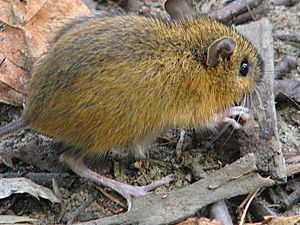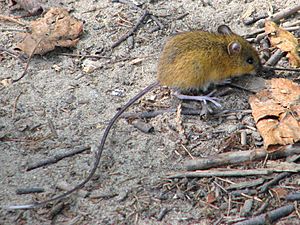Woodland jumping mouse facts for kids
Quick facts for kids Woodland jumping mouseTemporal range: Middle Pleistocene to Recent
|
|
|---|---|
 |
|
| Conservation status | |
| Scientific classification | |
| Genus: |
Napaeozapus
|
| Species: |
insignis
|
 |
|
The woodland jumping mouse (Napaeozapus insignis) is a small, active rodent found in North America. These amazing mice are known for their powerful hind legs and long tails, which help them jump incredible distances, sometimes up to 3 m (9.8 ft)! They live in cool, moist forests and meadows.
Contents
What is a Woodland Jumping Mouse?
The woodland jumping mouse belongs to a group of animals called jumping mice. These mice are special because they have very long tails and strong back legs, which are perfect for leaping. They are found in northern parts of the world, both in North America and other continents.
How Scientists Name Them
The woodland jumping mouse was first named Zapus insignis in 1891. But later, scientists looked closely at their teeth, ear bones, and other body parts. They found enough differences to give the woodland jumping mouse its own special group, called Napaeozapus. This helps scientists understand how different animals are related.
Types of Woodland Jumping Mice
Scientists have found five main types, or subspecies, of woodland jumping mice. They are named after the areas where they live:
- N. i. insignis in New Brunswick, Canada
- N. i. abietorum in Ontario, Canada
- N. i. saquenayensis in Quebec, Canada
- N. i. roanensis in North Carolina, USA
- N. i. frutectanus in eastern Wisconsin and Michigan, USA
Where Do They Live?
Woodland jumping mice live across the northeastern parts of North America. They prefer cool, damp forests with lots of spruce and hemlock trees. You might also find them where forests meet meadows, especially near streams. They love places with plenty of water and thick plants on the ground, like touch-me-nots.
What Do They Look Like?
The woodland jumping mouse is a medium-sized rodent. Mice living in the southern parts of their range tend to be darker in color. They have special features that help them live in cold places.
Their heads are small, and their teeth are unique. They have orange or yellow front teeth (incisors) that are grooved. They also have three molar teeth, but no premolars.
The mouse's tail is very long, making up about 60% of its total body length! It's dark brown on top and creamy white underneath, with a white tip. The tail helps them balance when they jump. Their long leg bones also help them leap and jump so well.
Mouse Measurements
Here are some average measurements for woodland jumping mice:
- Length (nose to tail tip): 205–256 mm (8.1–10.1 in)
- Tail length: 115–160 mm (4.5–6.3 in)
- Weight: 17–35 g (0.60–1.23 oz) (about the weight of a few grapes!)
Before hibernation in the fall, they can weigh more, around 26.5 g (0.93 oz), because they eat a lot to store fat.
How Do They Behave?
Talking and Sensing
Woodland jumping mice are usually quiet. Young mice might squeak, and adults make soft clucking sounds when they are sleeping or getting ready for hibernation. They are generally friendly with each other and don't fight much.
Like many animals, they likely use smells and chemical signals to recognize each other and tell males from females. They also probably use touch to communicate, especially between mothers and their babies.
What Do They Eat?
What a woodland jumping mouse eats depends on where it lives and the time of year. They often eat fungi, which are like tiny mushrooms that grow underground. They probably sniff them out! Fungi can make up a big part of their diet.
They also eat seeds, especially from plants like touch-me-nots. They enjoy insect larvae (like caterpillars) and various fruits. Beetles are also on their menu. During hibernation, they don't eat, so they need to build up enough fat beforehand to survive.
Seasonal Activities
Summer is the busiest time for woodland jumping mice. This is when they mate and have babies. Mice that wake up from hibernation spend a lot of time eating to get their weight back.
Some mice start hibernating as early as September, but most wait until late November. Before they hibernate, they spend more than two weeks gathering food and getting fat. During hibernation, their body temperature drops a lot, from 37 to 2 °C (99 to 36 °F). They wake up about every two weeks to go to the bathroom or eat from their hidden food stashes.
Sadly, only about one-third of the mice that hibernate survive the winter. The others might get too cold or be eaten by predators. Some mice don't hibernate at all; instead, they might move into people's houses to live in walls or old furniture, eating food scraps. The mice that do survive hibernation usually wake up around April.
Where Do They Live?
Woodland jumping mice live in nests or burrows. Nests are often found in hollow logs, under tree roots, or beneath rocks. Burrows can be almost anywhere, but they are usually hidden by plants. They build their nests from soft grasses, reeds, and leaves.
Their burrows often have several rooms, each for a different purpose:
- One room is for sleeping or hibernating, filled with soft nesting materials.
- Another room is for storing food for the winter.
- A third room might be used for mating and raising their young.
It's hard to study how much space these mice need in the wild. Males might use an area between 0.4–3.6 ha (0.99–8.90 acres), and females between 0.4–2.6 ha (0.99–6.42 acres). Their areas often overlap. If there's a lot of food, like ripe berries, many mice might gather there temporarily.
Reproduction and Life Cycle
The mating season for woodland jumping mice starts in May and lasts until August. Females usually have two or more litters (groups of babies) each year. A litter can have anywhere from 1 to 12 babies, but usually 3 to 6.
When they are born, the babies are pink and have no hair. Their eyes open around 26 days old, and they stop drinking milk around 30 days. By 34 days, they look like adult mice. The mother takes care of the young, and they stay in the nest together. The young mice leave the nest for good after about 34 days. Sadly, about 90% of young mice don't survive, often because of predators.
Who Are Their Predators?
Many animals hunt woodland jumping mice. Some known predators include Eastern screech owls, timber rattlesnakes, bobcats, broad-banded copperheads, American mink, weasels, and striped skunks.
Most woodland jumping mice live for about two years, but some can live for three or even four years.
Are They in Danger?
The woodland jumping mouse is currently listed as "Least Concern" by the IUCN Red List. This means they are not considered to be in danger of disappearing. They are common and found in many places, and their numbers seem stable.
However, there are some things that could become problems for them in the future. As land is developed, there are fewer suitable places for them to hibernate. Also, if there isn't enough snow in winter to insulate their burrows, many mice might die from the cold. In warmer areas, southern populations are already moving to higher, cooler places, and rising temperatures could threaten them. Scientists are still studying these mice to understand their populations and how to protect them.



